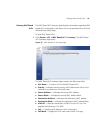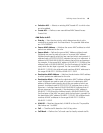
62 CHAPTER 4: MANAGING DEVICE SECURITY
Defining Access
Control Lists
Access Control Lists (ACLs) allow network managers to define
classification actions and rules for specific ingress ports. A network
manager can configure an ACL on an ingress port so that packets are
either admitted or denied entry. The user can also specify that when
packets are denied entry, the ingress port is also disabled.
For example, an ACL rule is defined stating that port number 20 can
receive TCP packets, however, if a UDP packet is received, the packet is
dropped. ACLs are composed of access control entries (ACEs) that are
made of the filters that determine traffic classifications.
The following are examples of filters that can be defined as ACEs:
■ Source Port IP Address and Wildcard Mask — Filters the packets
by the source port IP address and wildcard mask.
■ Destination Port IP Address and Wildcard Mask — Filters the
packets by the destination port IP address and wildcard mask.
■ ACE Priority — Filters the packets by the ACE priority.
■ Protocol — Filters the packets by the IP protocol.
■ DSCP — Filters the packets by the DiffServ Code Point (DSCP) value.
■ IP Precedence — Filters the packets by the IP Precedence.
■ Action — Indicates the action assigned to the packet matching the
ACL. Packets are forwarded or dropped. In addition, the port can be
shut down, a trap can be sent to the network administrator, or packet
is assigned rate limiting restrictions for forwarding.
This section includes the following topics:
■ Viewing MAC Based ACLs
■ Configuring MAC Based ACLs
■ Removing MAC Based ACLs
■ Viewing IP Based ACLs
■ Defining IP Based ACLs
■ Modifying IP Based ACLs
■ Removing IP Based ACLs
■ Viewing ACL Binding
■ Configuring ACL Binding
■ Removing ACL Binding


















